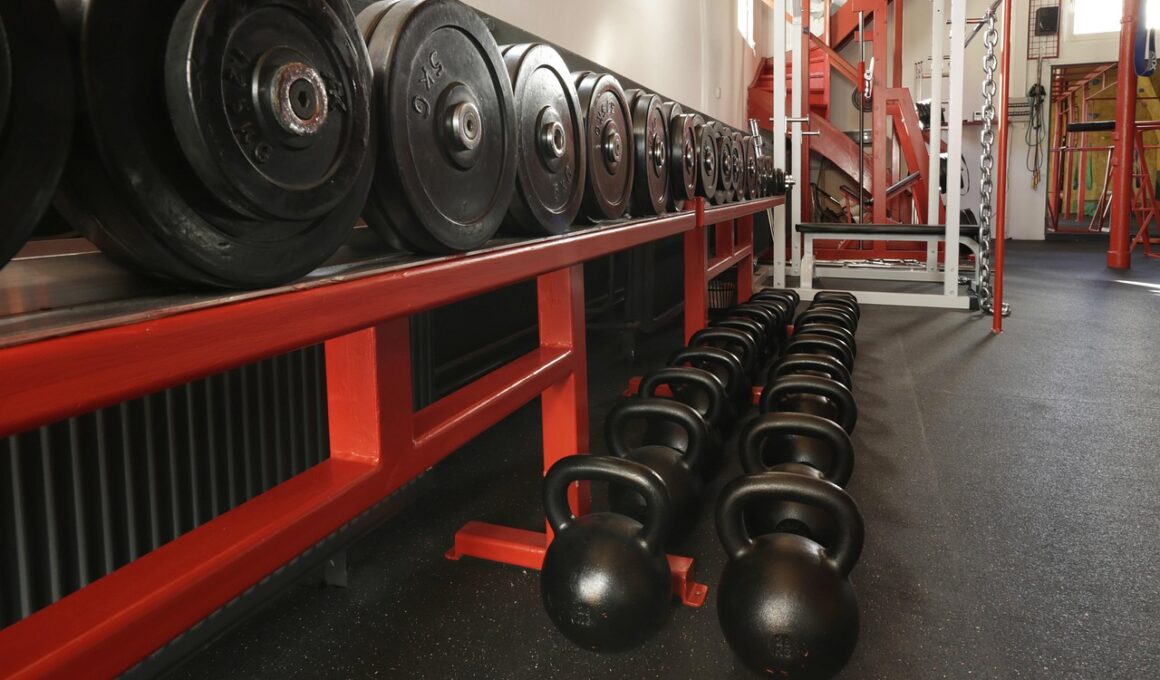Periodization Strategies for Plyometric Training in Competitive Seasons
Plyometric exercises play a significant role in enhancing athletic performance through strength, explosiveness, and agility. Implementing effective periodization strategies is essential for optimizing these attributes during competitive seasons. The primary goal is to structure training phases to maximize effectiveness while minimizing injury risks. In this regard, athletes must consider the intensity, volume, and specific exercise selection tailored to meet their performance goals. According to research, it is vital to arrange training cycles to allow for sufficient recovery while stimulating adaptations. Various frameworks exist, such as linear, undulating, and conjugated periodization models, each offering different benefits and drawbacks. For instance, linear periodization gradually progresses intensity while reducing volume. In contrast, undulating models create variability in stimuli to prevent plateaus. Moreover, it is critical to coordinate plyometric sessions alongside sport-specific training to ensure athletes maintain peak readiness during competitions. Coaches should prioritize communication with athletes to track progress and adjust training loads accordingly. Finally, integrating recovery strategies will support overall performance and longevity in the sport. A comprehensive approach ensures that athletes excel during crucial competition phases.
Foundational Concepts of Plyometric Training
Before delving into periodization strategies, it is crucial to understand the foundational concepts of plyometric training. Plyometrics emphasize the stretch-shortening cycle, which is advantageous for developing explosive strength through rapid eccentric contractions followed by immediate concentric actions. This unique method stimulates muscle fibers and enhances neuromuscular efficiency. To leverage the full potential of plyometrics, it is necessary to consider explosive exercises such as box jumps, depth jumps, and bounds. Understanding the physiological adaptations required for improved performance is essential when designing a training program. Furthermore, periodization requires careful consideration for both training intensity and volume. Higher intensity is crucial during specific phases, particularly leading to peak competitions. In contrast, lower intensity may be utilized during recovery phases to mitigate fatigue. The choice of plyometric exercises can vary based on season goals and competition levels. To ensure optimal gains, enthusiasts should regularly assess progress and modify training based on response to the load. Ultimately, this systematic approach helps athletes achieve the required physical readiness to tackle the competition head-on.
Another key element in plyometric training is exercise selection and its impact on performance enhancement. Incorporating a variety of plyometric exercises will target different muscle groups and facilitate comprehensive athletic development. Variability fosters adaptation and aids in preventing overuse injuries. Athletes can choose from several categories, including low-intensity, medium-intensity, and high-intensity plyometrics, depending on their experience level and current training phase. Low-intensity exercises, such as hopscotch or small jumps, are suitable during recovery periods. Conversely, medium-intensity exercises like tuck jumps or lateral bounds can help stimulate strength and power building. High-intensity activities, including depth jumps and single-leg hops, should be reserved for advanced phases closer to competition. Progression can also occur through increasing repetitions, sets, or decreasing rest intervals as athletes adapt. Accurate monitoring of fatigue indicators is crucial while using high-intensity exercises to prevent injury and overtraining. Additionally, coaches must implement proper warm-up and cool-down techniques alongside plyometric routines. Ensuring these aspects are covered will promote longevity in athletes and ensure consistently high performance.
Recovery in Plyometric Training
A key component of any successful training program is the emphasis on recovery strategies. Recovery in plyometric training cannot be overlooked, as athletes require adequate rest to allow for physical adaptations and replenish energy systems. A distinct focus on recovery during the competitive season is vital to maintain performance and prevent burnout. Proper hydration, nutrition, and sleep play essential roles in the recovery process. By adhering to recommended dietary guidelines and optimizing macronutrient intake, athletes can support muscle repair and adaptation. Furthermore, employing active recovery methods such as light jogging, stretching, and foam rolling significantly aids in reducing muscle soreness and stiffness. Scheduling recovery days into the training calendar is just as important as workload days to ensure a balanced approach. It may also be beneficial to incorporate low-intensity, sport-specific practice during recovery phases to maintain overall fitness levels while reducing stress on the joints. Thus, a comprehensive recovery strategy, alongside structured periodization, directly influences athletic performance. Ensuring these strategies are well integrated will maximize athletes’ potential throughout the competitive season.
Monitoring athletes’ readiness and responses to training loads is paramount for optimal performance during competitive seasons. Implementing training load management techniques allows coaches to gauge whether athletes are adapting favorably to plyometric training. One widely recognized method involves using subjective measures, such as the Rate of Perceived Exertion (RPE). Athletes can provide feedback on their training experiences, which helps coaches make informed decisions about necessary modifications. Objective measures, such as heart rate monitoring and force-output assessments, offer insight into athletes’ physical capabilities and recovery rates. Utilizing both subjective and objective tools creates a rounded perspective on athletes’ readiness levels. Incorporating performance metrics, including jump heights and power output, further enhances monitoring practices. Regular assessments will help ensure athletes progress appropriately through their training cycles. Moreover, coaches should remain attuned to any signs of fatigue or overtraining, which may require immediate adjustments to the program. By investing time into monitoring training responses, coaches can maintain high-performance levels while lowering potential injury risks, thereby extending athletes’ competitive careers.
Practical Applications of Plyometric Periodization
The practical application of periodization techniques for plyometric training is essential for competitive success. Coaches can use various models to create effective schedules tailored to individual athlete needs, ensuring an optimal balance of workload throughout the season. A linear periodization model typically emphasizes progressively increasing intensity and specificity as competition approaches. Coaches can strategically design cycles to include various plyometric exercises that match the specific demands of the sport to enhance specific skills. On the other hand, undulating periodization introduces variability, alternating between high and low intensity throughout the week. This model prevents monotony and helps maintain enthusiasm amidst rigorous training schedules. Additionally, athletes can engage in concurrent training, combining plyometrics with strength and aerobic exercises to improve overall fitness. This multi-faceted approach enables greater adaptability and prepares athletes better for their respective sport outcomes. Regardless of the chosen model, the key lies in ensuring that athlete loads and recovery are continually assessed and adjusted based on real-time feedback. Successful application leads to improved performance outcomes and increased athlete confidence during competitions.
Ultimately, the synergy between plyometric training and periodization strategies empowers athletes to achieve peak performance during their competitive seasons. By implementing the concepts discussed, athletes can enhance strength, speed, and agility through a well-structured training program. Understanding the essential balance between intensity, exercise selection, and recovery ensures athletes receive the right stimulus for adaptation while preventing injuries. Coaches should continuously evaluate training outcomes and modify components to align with the athletes’ needs and goals. Integrating plyometric training within a comprehensive sports training regime transcends mere participation—it’s a critical pathway to athletic excellence. Emphasizing communication between the athlete and coach helps foster an environment of trust and collaboration, ultimately allowing athletes to reach their full potential. As the sport landscape evolves, so too should the strategies in plyometric training. Incorporating modern methodologies alongside proven principles will ensure that athletes remain at the forefront of sports performance. In conclusion, prioritizing periodization with plyometric exercises effectively catalyzes athletic development throughout the rigorous demands of competitive seasons.
In closing, the ever-evolving field of sports performance continuously offers new insights into plyometric training methodologies and effective periodization strategies. Athletic coaches and practitioners must stay informed and adaptive, enabling them to harness the latest research and trends to optimize athlete development. This progressive outlook is not only vital for improving competitive performance but also reinforces a culture of lifelong learning within the coaching landscape. Adapting training protocols based on evidence ensures the highest level of athlete care and success. As we move forward, embracing collaboration between various coaching and sports science disciplines will yield advancements in plyometric training and athlete conditioning. A multi-disciplinary approach can inspire innovation and creativity in developing training programs focused on enhancing athletic capabilities. Moreover, athletes play an essential role in their own development through proactive communication, feedback, and dedication to training efforts. Together, coaches and athletes create winning partnerships, fostering resilience and excellence within various competitive environments. Consequently, this comprehensive framework promotes longevity and success for athletes, providing a pathway toward achieving performance goals while encouraging consistent improvement throughout their careers.


